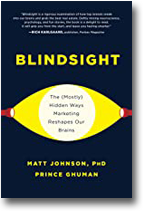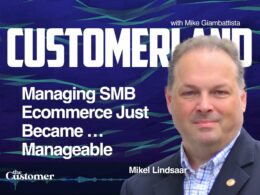Personalization caters to our past, albeit sometimes the very recent past. Importantly, the content is not based on who we could be, or who we might be, but on who we were.
Technology has democratized access to digital content, bringing us the world at our fingertips. With the touch of a few buttons, we can listen to any song, watch any video, read any article, or watch any video.
by Matt Johnson, Phd., and Prince Ghuman
It’s an incredible feat. But of course, we can’t consume this entire corpus of digital content. Even if we could pause new digital uploads, and spend the next thousand years glued to a screen, we could never get through even 1% of what currently exists.
We can’t eat the entire digital pie; we have to nibble away at a very thin slice. But this is key: it’s not just any random slice. It’s a sliver of content and digital experiences which is catered specifically for you. You can’t read every news article, so we’re shown the ones which you’re likely to deem most relevant. You can’t listen to every possible song, so we’re shown playlists that fit your tastes. Our slice is content born of our own tastes, preferences, and beliefs.
Put simply, you don’t have THE world at your fingertips; we have YOUR world at your fingertips.
At first blush, this sounds ideal. We can’t consume everything, and even if we could, would we want to waste our time on things we don’t like? If we can only get a slice of the pie, wouldn’t we want the “best” slice? Don’t we want the internet to give us our own, hyper-personalized, creme de la creme?
It’s worth questioning the superiority of having unabated access to a personalized sliver of the world. Is there a unique benefit to getting things that are not explicitly designed for us? Let’s dive into the perils of personalization.
How Personalization Drives Consumer Behavior
It’s worth reflecting on just how deep this personalization goes. If the internet, as a whole, can be said to have any “natural” tendencies, it’s this: it will find a way to conform to us. It naturally reflects our preferences, beliefs, and desires back to us. It’s become a major driving force of consumer behavior, especially online.
Ronny Chieng provides a hilarious illustration of this in a 2019 comedy sketch. He sardonically laments that Amazon Prime is way too slow. He decries, “Same day delivery? Same day?? So unamerican. I want it now! As soon as I press the button, I want it in my hands, there should be no lag”.
It’s a hilarious bit, illustrating just how spoiled, demanding, and yet unhappy the American consumer has become. But the genius of the sketch is still to come. He takes this to its logical terminus, asking, “Where do we go from here, as a civilization? How much more convenience can we want?” The answer comes back to curation. Not just delivering what you want, but pre-empting what you want. Or, as Chieng describes, “No more Prime Now. Let’s get Prime Before. It’s 2019! I have to make a decision? .. Send me everything I want before I want it.”
It’s hyperbolic, of course, but it speaks to the deeper trend of personalization. Not only can we get almost anything we want, with ever-increasing convenience, but our desires themselves are identified before we even realize it. So much of marketing psychology is about creating experiences that are individualized.
Amazon is just one example. Personalization is a much more general feature of the digital environment. With every swipe, like, or selfie, algorithms learn more about what we want and how we like it delivered. At their most benign, algorithms learn more and more about you to deliver you increasingly personalized content.
In a world rich in consumer data, this is everywhere. Digital platforms of all stripes are thoroughly in the personalization business. From Spotify’s Daily Discovery, to Netflix’s “for you” algorithm, to your Apple / Google News, you’re hard-pressed to find a corner of the internet that isn’t, to a certain extent, learning and personalizing. Facial recognition is getting in on the game, and even airline safety videos are getting more individually tailored.
On the surface, this approach seems like pure upside for the consumer. Instead of being bored with irrelevant ads, we learn about products we might find interesting. And on entertainment platforms like YouTube, Spotify, and Netflix, personalized recommendations save us countless hours of sifting and triage.
But it’s worth taking a step back and think about what we might be missing. Maybe always getting what we like – or what we think we like – has its drawbacks.
The Consumer Psychology of Personalized Content
As we’ve seen, algorithmic personalization can lead to echo chambers. One’s worldview is shaped, to a large extent, by the media content they consume, and when each new piece of media is personalized, it serves to reinforce one’s preexisting beliefs. It’s confirmation bias gone wild, and it ossifies one’s beliefs.
But the perils of personalization go beyond this. This same ossification may happen to an entire individual: Not just our beliefs, but our preferences, ideas, and even our personality.
Consider this: When we get a piece of personalized content, who exactly is it personalized for? It’s an algorithmic model of a person which is necessarily based on historical data and past behavior. It’s our social media activity, browsing history, purchases, etc, all of which, of course, has already happened.
Personalization caters to our past, albeit sometimes the very recent past. Importantly, the content is not based on who we could be, or who we might be, but on who we were. It’s our shadow staring back at us. The constant reception of content aimed at our past self may hold us at a personal standstill. In this way, personalized content just makes the person even more of who they already are.
Of course, algorithms aren’t giving us exactly what we already like. These aren’t specific songs we’ve heard before or movies we’ve already watched. Instead, they give you what we’re likely to like, based on your digital history. Spotify and Netflix give you songs and movies, respectively, which fall within your “personalized zone.” This content is technically new to us, but because it exists within this zone, it still feels eerily familiar. But it’s this perpetual feeling of familiarity across our digital existence – new things, which feel old – which may be holding us back.
What are we missing when we exist, more and more, within the confines of our own preferences?
 Johnson and Ghuman are founders of “PopNeuro – a Neuromarketing Blog for the masses” and co-author of “Blindsight – The (mostly) hidden ways marketing reshapes our brains”.
Johnson and Ghuman are founders of “PopNeuro – a Neuromarketing Blog for the masses” and co-author of “Blindsight – The (mostly) hidden ways marketing reshapes our brains”.
This article originally appeared in PopNeuro. Photo by Rob Martin on Unsplash.













